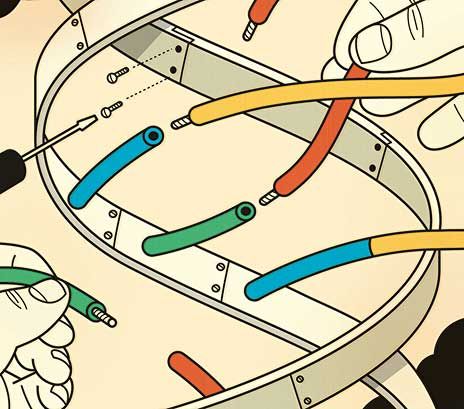Bioengineering technology is maturing, and so is its vocabulary

Illustration: Harry Campbell
BY Paul McFedries // October 2009
A n oxymoron is a phrase that combines two contradictory words, such as "jumbo shrimp" and "deafening silence." Appropriately, the word oxymoron is itself an oxymoron, from the Greek oxymõros, which means "pointedly foolish," but the roots of the word are oxys, "sharp," and mõros, "dull."
A relatively new oxymoron is synthetic biology, coined by the geneticist Waclaw Szybalski in 1974. Synthetic biology (also called synbio) uses engineering methods to produce something new by treating a living system not so much as a biological entity but as a kind of technology. Hence synthetic biology is also called biological engineering or just bioengineering.
If a synthetic biologist focuses on genetic modifications using custom-built genes instead of naturally occurring ones, then he or she is practicing synthetic genomics. A biological system augmented with nonnatural components is a semiotic system.
Engineers require standardized parts, and bioneers are no different. BioBrick biological parts were designed at MIT by Tom Knight and his colleagues to be incorporated into living cells for the construction of new biological systems. The term BioBricks was trademarked in 2006 by the BioBricks Foundation, and now biobricks is commonly used as a synonym for bioparts, which consist of DNA sequences that have a standard structure and perform a well-defined function. The most basic is the biobrick part, which encodes a standard biological function and acts as a kind of biological building block; next in the hierarchy is the biobrick device, which consists of several biobrick parts that together perform some function (defined not by nature, but by the engineer); finally, there's the biobrick system, a collection of biobrick parts and devices that performs some high-level function. My favorite example is the wonderfully named repressilator, created by the physicist Michael B. Elowitz and the geneticist Stanislas Leibler. This biobrick system contains three genes connected in a feedback loop in which each gene represses the next at regular intervals. The result is the biological equivalent of an electrical oscillator.
Biobricks require host cells to ride in, often called the chassis or the hardware. The host role is often filled by the famous E. coli bacterium. But E. coli, yeast, and other natural cells are complex and can interfere with whatever function the inserted genetic device is trying to perform. So scientists sometimes use as a chassis a minimal cell, which has the minimum number of components to allow the cell to support the synthetic system. Other bioneers prefer the cell-free approach, where the synthetic biological system rests in a bath of biochemical components in which the device can do its thing.
Today synthetic biology is the domain of big-time scientists, but biobrick parts will usher in a new era of DIY biology, where biohackers and other members of the open-source biology movement mess with DNA and build new biological systems biobrick by biobrick.
What new genetic machines will we see with all this molecular tinkering? Some examples include advanced biosensors engineered to detect diseases; biofuels derived from biomass (like sugarcane); the biofabrication of scaffolds used in tissue engineering; and biodrugs that are cheaper and more powerful than existing medications.
Synthetic biology will surely also generate a new category of evildoer—the bioterrorist who will try to biohack nasty pathogens that will wreak havoc on society. Actually, that era may already be upon us with the recent announcement from the firm Ginkgo BioWorks of the BioBrick Assembly Kit (see http://ginkgobioworks.com/biobrickassemblykit.html) which, for a mere US $235, gives you a collection of biobrick parts and all the equipment you need to break into biohackerdom.
While the fearsome possibilities of dark biology aren't to be dismissed—and indeed synthetic biology as a whole must leap a number of ethics and security hurdles before it becomes the megabuck industry that everyone predicts—I can't wait for the day we finally see that "new better mouse
0 comments:
Post a Comment